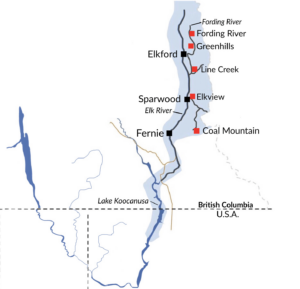By Derf Johnson
Massive metallurgical coal strip mines in British Columbia’s Elk Valley, owned and operated by Teck Coal, are causing pollution runoff from the mine sites into adjacent waterways, including dangerous levels of selenium. Ultimately, this pollution enters the Kootenai River, which flows into Montana and forms Lake Koocanusa. Over the past decade, selenium levels in the Kootenai River and Lake Koocanusa have continued to rise, impacting Montana’s world-class fishery. The Bullock Administration recognized the problem, and its Board of Environmental Review (BER) conducted a rulemaking which established a site-specific selenium standard of 0.8 micrograms per liter for Lake Koocanusa in an attempt to address the problem. These rules were the product of a multi-year effort among state agencies, Tribes, and local organizations, and finalized in December 2020.

Lake Koocanusa is downriver of several Teck coal mines, indicated by red squares here. Map via The Narwhal.
Enter Gov. Greg Gianforte.
Gov. Gianforte appointed a majority of the newest members of BER, who overwhelmingly represented current and former industry lobbyists and employees (fox, meet hen). The new BER responded to a Teck Coal petition to throw out the standard by conducting a short process known as a “stringency review,” where the rule is compared to federal standards to determine if it is more stringent. If so, the state must justify that increased stringency. The Montana Department of Environmental Quality (DEQ) – even with a Gianforte-appointed director – strongly disagreed with the attempt to roll back selenium standards and opposed the change throughout the BER process. Nevertheless, BER sided with Teck, ruling that the selenium standards were invalid and DEQ had to conduct a new rulemaking. Setting aside the serious, substantive problems associated with this BER ruling, it was also well outside BER’s jurisdiction and statutory authority to order DEQ to revise the selenium rule because the 2021 Legislature passed a bill by Sen. Duane Ankney that eliminated BER’s authority to make rules.
In fact, the order issued by BER went so far as to prompt DEQ to file a lawsuit in Montana District Court against BER for ordering it to revise the standard. DEQ is essentially arguing (correctly) that it alone has the jurisdiction and authority to conduct a rulemaking, and cannot be ordered by BER to do so. To rephrase, what we have is an administrative body, which serves administratively under the DEQ, being sued by its own department. An executive agency of Gov. Gianforte suing a Gianforte-appointed board.What a cluster.
Unfortunately, DEQ has only challenged the authority of the BER to order DEQ to conduct a rulemaking, not the underlying finding by BER that the site-specific selenium standard was more stringent than federal law. Based upon this failure, MEIC and our partners have also taken BER to court to challenge both BER’s faulty directive to DEQ and BER’s determination that Montana’s selenium standard is more stringent than federal law.
Importantly, the U.S. Environmental Protection Agency (EPA) has established a national selenium standard of 1.5 micrograms per liter that states must comply with in order to protect beneficial uses of waterways. However, EPA also recognized that the one-size-fits-all standard would not be appropriate for all settings and developed a process whereby states could establish site-specific standards that would be protective of beneficial uses of water. This EPA-developed and sanctioned process was used by Montana to establish the 0.8 micrograms per liter standard. BER simply compared one number to the other in making its determination and did not evaluate or consider EPA’s full suite of water quality protection tools.
The real head-scratcher in all of this is that Montana doesn’t stand to benefit at all in rolling back the selenium standards. All of the jobs and tax revenue are located in Canada, and Montana is just at the end of Teck’s pollution pipe.
The legal challenge against BER was filed in May in Montana’s 1st Judicial District Court in Helena. MEIC is represented by Earthjustice in this suit, and joined by the Clark Fork Coalition, Idaho Conservation League, and Idaho Rivers United.
This article was published in the June 2023 issue of Down To Earth.

